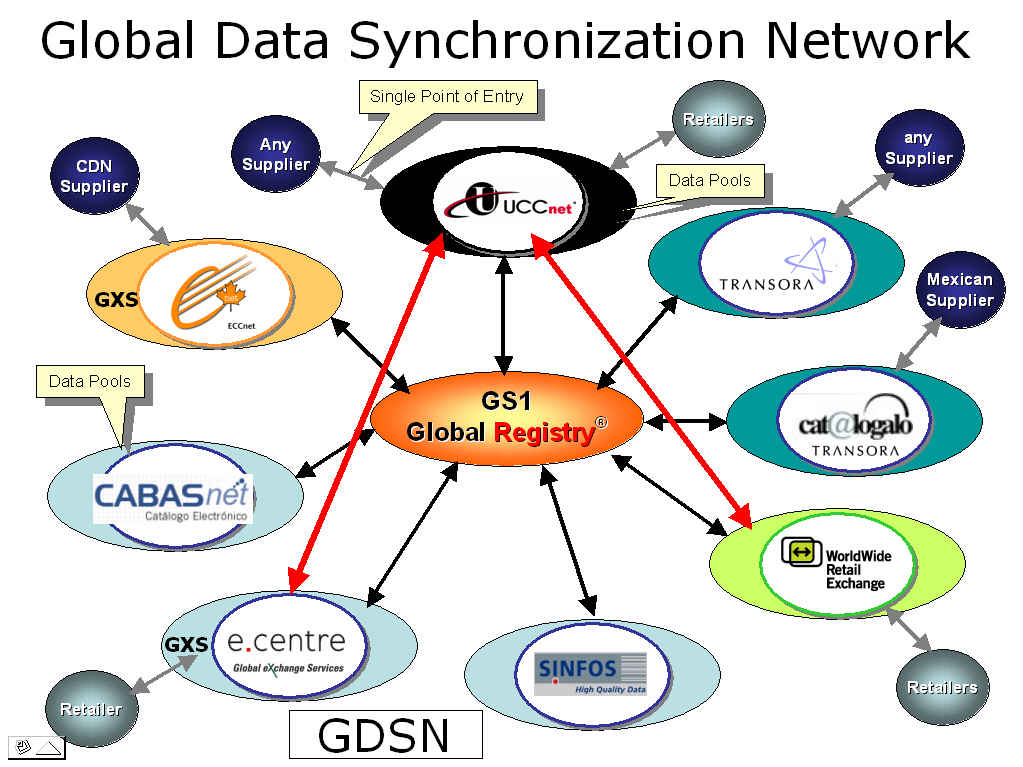UCCnet has had a tumultuous ride over the last year. Leading the data synchronization movement from an open standards perspective for the last four years, UCCnet is now part of a much larger initiative, Global Data Synchronization (GDS), that has changed the landscape considerably.
EAN.UCC developed GDS as a standards-based approach to resolve product data inaccuracies among trading partners. The physical implementation of GDS is the Global Data Synchronization Network (GDSN), which enables country-specific data pools, such as UCCnet and Transora in the United States, to register Global Trade Item Number (or GTIN, pronounced "gee-tin") information in the GS1 Global Registry. GTIN is the term used to describe a unique item (SKU or UPC) for a given packaging level, such as consumer unit, case, pallet, etc. Once registered, GTIN information can be published to any trading partner worldwide that subscribes to a GDSN-certified data pool. (Note: GS1 is the new name for EAN International.)
Essentially, GDSN synchronizes item data between supply-side and demand-side trading partners. A retailer's inaccurate information accounts for lost shelf time and costly deductions. By implementing GDS, a retailer forms a nonproprietary basis for collaborative capabilities among its trading partners. It's difficult for two trading partners to engage in transactional collaboration if they can't agree on the definition (descriptors, dimensional attributes, etc.) of what a trade item actually is.
GDSN ensures that all subscribing trading partners are synchronizing standards-compliant data. At the heart of GDSN is the GS1 Global Registry, which is accessed and updated by a certified data pool. Two levels of messaging co-exist: The first is that of a subscriber sending/receiving item data to its chosen data pool (typically via XML), and the second is the messaging between data pools, which is specific XML messaging dictated by GDSN.
UCCnet and GDS grew in tandem and then merged early this year when GS1was officially rolled out on August 3, 2004. Until then, UCCnet "owned" the GLOBALregistry, and many of us assumed that their version would be the worldwide standard that other data pools would access. Now, UCCnet is just one of many data pools in the United States and around the world that access the GS1 Global Registry to obtain item and party information (see Figure 1).
Bumps in the Road
Before going any further, let's clear up some misinformation. The GS1 Global Registry is not a big database in the sky providing item information for trading partners. It stores only eight GTIN attributes, at present, that uniquely identify a GTIN and a number of key attributes. It is an index that points data pools to where they should send XML synchronization documents, as depicted in Figure 1.

Figure 1: The GDSN tells data pools where to send XML documents. (Click image to enlarge.)
The GS1 Registry is accessed by a distributed network of data pools, each holding subscriber GTIN information that can be accessed by other data pools (acting upon requests from their subscribers). Quite honestly, it is a well-architected model that will not break if one data pool goes offline.
The Uniform Code Council (UCC) is UCCnet's parent organization, and it facilitates standards in five areas for its subscribers, who span 23 industries. UCCnet and GDSN have rapidly evolved to meet the needs of many industries other than the food industry and CPG (which were the first adopters of UCCnet), such as hardlines, the office supply industry, and soon the apparel industry. Starting with a basic model of manufacturers' publishing item information to retailers, UCCnet has evolved to support all trading partners in the supply chain, including distributors and wholesalers.
The 14-digit GTIN number encapsulates that of the North American 12-digit UPC and the European 13-digit article number. A GTIN is required for all levels in the containment structure, tying together the consumer units with all the various packaging levels. For example, a 12-ounce bottle of water (the consumer unit) could be in a case of 24 bottles (the orderable unit) with 46 cases comprising a pallet (the delivered unit). In this scenario, three GTINs would be assigned. So a food manufacturer that has 500 UPC codes could potentially be maintaining 1,500 GTINs.
The supplier, manufacturer, or brand owner must issue GTINs based on the GTIN allocation rules as set forth by GS1. GDS Solution Partners prove their value by providing a certified software solution that speaks to one or more data pools (more on that later in this article); they also provide the training and mentoring required for a trading partner to create GTINs from its existing systems and to "onboard" to GDSN.
Avoiding the Data Pool Whirlpool
Considerable confusion and misinformation has swirled around GDSN to the detriment of those trading partners wishing to be good citizens and comply with their retailer mandates. I believe many parties, including UCCnet, caused this confusion by not allaying those fears and addressing them at an earlier stage. As of October 2004, approximately 4,000 subscribers have joined up with UCCnet. Other data pools are private organizations that don't share information such as how many subscribers they have.
The situation is similar to a big land grab, as each data pool looks to win as many subscribers as possible. Some data pools are making questionable statements to entice, encourage, or even bully suppliers to subscribe to their given data pool services. If a data pool has signed up a large retailer mandating GDS, then that data pool has gained special leverage, and it may issue letters to suppliers detailing that relationship. Some letters state that a given retailer has attribute requirements beyond the GDSN standard and only that data pool can provide those requirements. The truth is that many retailers ask for only the basic attributes that are fully supported in the GDSN model. (Currently, there are 151 attributes in addition to industry class extensions.) Carefully examine these statements that data pool services make and ask the right questions. Look into who funds the data pool and determine whether there is a conflict of interest with your company's welfare.
To compound these problems, a few isolated retailers are refusing to subscribe to GS1, even though the GS1 data pool provides access to GDSN. This is forcing many suppliers to either join that retailer's data pool or pay subscription fees to both UCCnet (if that's the supplier's primary data pool) and the retailer's data pool. This goes against the principles of the original goal.
Let's review the objectives. GDSN was designed as a single point of entry where a trading partner (supplier, distributor, or retailer) subscribes to one data pool to onboard them to the network. Think of this as a dial tone; it doesn't matter what service provider the second party is using because you can call them as long as you have their phone number (in the GDSN model, this would be the Global Location Number, or GLN). Would you really want to subscribe to both AT&T and Sprint just because you use one service and your customers use another? Of course not! You and your customers expect your service providers to conform to the same standards.
In the GDSN model, the data pool has to be certified as a source data pool (representing suppliers), a recipient data pool (representing retailers), or both. A trading partner doesn't have to subscribe to multiple data pools simply because their trading partners are subscribing or connecting to data pools other than their own.
Many top retailers are now in production with GS1 or are testing it with key suppliers. Until GDSN is in full production and the standards bodies work through their growing pains, there will be some redundancy and you may have to join more than one data pool or implement some stopgap measures (such as EDI) to satisfy your customers.
Choose your data pool carefully by researching fee structures (do they include GS1 fees?) and determining what value-added services they provide that you may need. Many data pools, such as UCCnet and Transora, will recommend a solution partner that is certified for their messaging standard and has also demonstrated a proven track record of onboarding trading partners to their data pool.
A Fork in the Road
Which way to go: to be hosted or to be integrated? By now, many suppliers have been inundated by solution partners offering to onboard them to UCCnet or other competing data pools. There are two primary solution options, hosted and integrated:
Hosted
You access an application hosted by a service provider (typically via a browser), key in your GTIN information, and perform the necessary synchronization messaging with your trading partners. Small suppliers typically choose this option as they have only a handful of GTINs to register and synchronize.
Advantages: This option has a relatively low yearly cost, has no software to install, and is simple to use.
Disadvantages: In a hosted option, all GTIN information must be keyed in manually, there is no integration with other systems, and there is no workflow to trigger messaging when GTIN data changes on your line-of-business (LOB) system. This option could incur per-transaction costs on top of fixed subscription fees.
Integrated
A company installs and implements data synchronization software on a server behind a firewall. This option is usually sophisticated and incorporates workflow so that the building and maintaining of GTIN data is a collaborative effort between departments such as sales, marketing, product development, logistics, and so on.
Advantages: This option integrates with your existing LOB systems and leverages existing item data without re-keying it. The solution is a one-time purchase and incurs no per-transaction fees.
Disadvantages: A capital expenditure is required, but it may often be rolled into a lease.
Whether you choose a hosted or integrated solution depends on whether you are thinking strategically or tactically. Here are some factors to consider:
- How many GTINs do you have now?
- How often do you introduce new products to the marketplace?
- How often do product attributes change?
- How many departments and people need to interact with GDS?
When in Doubt, Ask for Directions
For the last two years, UCCnet Solution Partners have been on the ride of their life to continually update and enhance their product offerings (and be re-certified with each new version) to account for countless upgrades in the UCCnet messaging engine. A small number of Solution Partners now account for 90% of all the implementations at UCCnet (to view this list, click here). This is a typical consolidation model as an industry initiative matures, and only those providers that have invested heavily and shown a proven track record are being sought out by trading partners. For those Solution Partners who hung on during that ride, life is beginning to stabilize.
If you are new to data synchronization and have mandates to comply, seek out companies in your industry and ask lots of questions like these:
- What was the key functionality that drove their vendor decision?
- How long did it take to implement the solution?
- What assistance and mentoring was provided?
- What is the provider's ability to keep current with new releases, courseware, and documentation?
The answers to these questions will give you a map to follow on your data synchronization journey.
Alan Christensen is the vice president of solution products for LANSA and has led the development of LANSA's eBusiness solutions for B2B as well as Data Synchronization, EDI-INT and RFID. Alan has 20+ years architecting and implementing enterprise supply chain solutions. You can reach Alan at
Sidebar: GDSN Legend of Terminology
Global Data Synchronization Network (GDSN): A network of interoperable data pools that enable Global Data synchronization (GDS) per EAN.UCC system standards.
Global Location Number (GLN): A globally unique, 13-digit number that identifies a physical, functional, or legal entity. When a company subscribes to a data pool, it is issued a GLN.
Global Trade Item Number (GTIN): A globally unique 14-digit number that identifies trade items (products or services). GTIN is an umbrella term for all current variants of the UCC-12, EAN.UCC 13, and EAN.UCC 8 data structures.





















 More than ever, there is a demand for IT to deliver innovation. Your IBM i has been an essential part of your business operations for years. However, your organization may struggle to maintain the current system and implement new projects. The thousands of customers we've worked with and surveyed state that expectations regarding the digital footprint and vision of the company are not aligned with the current IT environment.
More than ever, there is a demand for IT to deliver innovation. Your IBM i has been an essential part of your business operations for years. However, your organization may struggle to maintain the current system and implement new projects. The thousands of customers we've worked with and surveyed state that expectations regarding the digital footprint and vision of the company are not aligned with the current IT environment. TRY the one package that solves all your document design and printing challenges on all your platforms. Produce bar code labels, electronic forms, ad hoc reports, and RFID tags – without programming! MarkMagic is the only document design and print solution that combines report writing, WYSIWYG label and forms design, and conditional printing in one integrated product. Make sure your data survives when catastrophe hits. Request your trial now! Request Now.
TRY the one package that solves all your document design and printing challenges on all your platforms. Produce bar code labels, electronic forms, ad hoc reports, and RFID tags – without programming! MarkMagic is the only document design and print solution that combines report writing, WYSIWYG label and forms design, and conditional printing in one integrated product. Make sure your data survives when catastrophe hits. Request your trial now! Request Now. Forms of ransomware has been around for over 30 years, and with more and more organizations suffering attacks each year, it continues to endure. What has made ransomware such a durable threat and what is the best way to combat it? In order to prevent ransomware, organizations must first understand how it works.
Forms of ransomware has been around for over 30 years, and with more and more organizations suffering attacks each year, it continues to endure. What has made ransomware such a durable threat and what is the best way to combat it? In order to prevent ransomware, organizations must first understand how it works. Disaster protection is vital to every business. Yet, it often consists of patched together procedures that are prone to error. From automatic backups to data encryption to media management, Robot automates the routine (yet often complex) tasks of iSeries backup and recovery, saving you time and money and making the process safer and more reliable. Automate your backups with the Robot Backup and Recovery Solution. Key features include:
Disaster protection is vital to every business. Yet, it often consists of patched together procedures that are prone to error. From automatic backups to data encryption to media management, Robot automates the routine (yet often complex) tasks of iSeries backup and recovery, saving you time and money and making the process safer and more reliable. Automate your backups with the Robot Backup and Recovery Solution. Key features include: Business users want new applications now. Market and regulatory pressures require faster application updates and delivery into production. Your IBM i developers may be approaching retirement, and you see no sure way to fill their positions with experienced developers. In addition, you may be caught between maintaining your existing applications and the uncertainty of moving to something new.
Business users want new applications now. Market and regulatory pressures require faster application updates and delivery into production. Your IBM i developers may be approaching retirement, and you see no sure way to fill their positions with experienced developers. In addition, you may be caught between maintaining your existing applications and the uncertainty of moving to something new. IT managers hoping to find new IBM i talent are discovering that the pool of experienced RPG programmers and operators or administrators with intimate knowledge of the operating system and the applications that run on it is small. This begs the question: How will you manage the platform that supports such a big part of your business? This guide offers strategies and software suggestions to help you plan IT staffing and resources and smooth the transition after your AS/400 talent retires. Read on to learn:
IT managers hoping to find new IBM i talent are discovering that the pool of experienced RPG programmers and operators or administrators with intimate knowledge of the operating system and the applications that run on it is small. This begs the question: How will you manage the platform that supports such a big part of your business? This guide offers strategies and software suggestions to help you plan IT staffing and resources and smooth the transition after your AS/400 talent retires. Read on to learn:
LATEST COMMENTS
MC Press Online